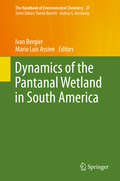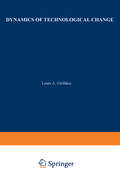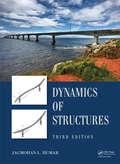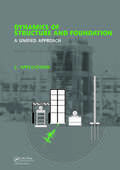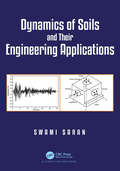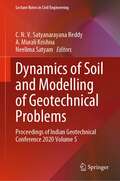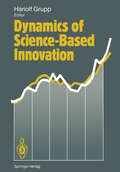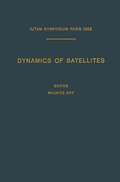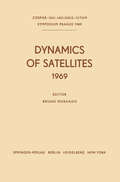- Table View
- List View
Dynamics of the Rigid Solid with General Constraints by a Multibody Approach
by Nicolae Pandrea Nicolae-Doru StanescuCovers both holonomic and non-holonomic constraints in a study of the mechanics of the constrained rigid body. Covers all types of general constraints applicable to the solid rigid Performs calculations in matrix form Provides algorithms for the numerical calculations for each type of constraint Includes solved numerical examples Accompanied by a website hosting programs
Dynamics of the Pantanal Wetland in South America (The Handbook of Environmental Chemistry #37)
by Ivan Bergier Mario Luis AssineThis book provides readers with in-depth insights into the changes in the Pantanal wetland from its formation to the actual and likely future states. It reveals that today’s Pantanal is an evolutionary consequence of geological, ecological and, more recently, man-made events taking place at distinct space-time intervals. Topics include geotectonics and sun-earth interactions, which largely dictate the rate of drastic changes that eventually disrupt ecological stability and radically rebuild the regional landscape. Furthermore, the biota-climate system is discussed as a major driver reshaping the ecohydrology functioning of the landscape on an intermediate timescale. Also covered are major changes in the landscape ecohydrology and biodiversity due to recent land-use and climate changes induced by humankind in the Anthropocene. The ability to recognize how those temporal scales impact the Pantanal wetland provides the opportunity for wise management approaches and the sustainable development of the region.
The Dynamics of the Computer Industry: Modeling the Supply of Workstations and their Components
by Walid Rachid ToumaComputers communicate globally via satellite or fiber optic links, wide area networks share resources thousands of miles away, and the average home can have the capacity of access information at the push of a button - the digital information age has arrived! Several technologies have made this computer age possible, helped it grow, and affected its dynamics over time. This book addresses the problem of formulating a model that interrelates the factors that drive the supply of these technologies over time to the attributes of the computers that are manufactured from them.
Dynamics of the Axially Moving Orthotropic Web (Lecture Notes in Applied and Computational Mechanics #38)
by Krzysztof MarynowskiA material continuum moving axially at high speed can be met in numerous different technical applications. These comprise band saws, web papers during manufacturing, processing and printing processes, textile bands during manufacturing and processing, pipes transporting fluids, transmission belts as well as flat objects moving at high speeds in space. In all these so varied technical applications, the maximum transport speed or the transportation speed is aimed at in order to increase efficiency and optimize investment and performance costs of sometimes very expensive and complex machines and installations. The dynamic behavior of axially moving systems very often hinders from reaching these aims. The book is devoted to dynamics of axially moving material objects of low flexural stiffness that are referred to as webs. Webs are moving at high speed, for example, in paper production the paper webs are transported with longitudinal speeds of up to 3000 m/min. Above the critical speed one can expect various dynamical instabilities mainly of divergent and flutter type. The up-to-date state of investigations conducted in the field of the axially moving system dynamics is presented in the beginning of the book. Special attention is paid on nonlinear dynamic investigations of translating systems. In the next chapters various mathematical models that can be employed in dynamic investigations of such objects and the results of analysis of the dynamic behavior of the axially moving orthotropic material web are presented. To make tracing the dynamic considerations easier, a paper web is the main object of investigations in the book.
The Dynamics of Technology: A Methodological Framework for Techno-Economic Analyses (Theory and Decision Library A: #25)
by G. BarbiroliTechnology is taking on an increasingly central and determining role in so ciety, and can provide contradictory results: wealth on the one hand, but also unemployment, environmental imbalances and other social problems on the other. Manufacturing techniques and production organization are chosen in every country based mainly on the specific needs of the companies, while the real needs of each population are often quite different. Already, in order to prevent all forms of technology from becoming in creasingly "invasive", towards both the natural supply of resources and the specific - though highly differentiated - needs of humanity, technological paths must be identified and followed which are capable of making the vari ous needs compatible, from the standpoint of sustainable development, the conservation and increase in value of natural resources, and the quality of development. This will become increasingly important in the future. This goal is undoubtedly ambitious and difficult to achieve; however, evi dence of the problems caused by generalized, uncontrolled use of technolo gy, all over the world, leads us to believe that intense efforts must be made to achieve this aim. If not, humankind runs the risk of an irreversible degra dation of the most important aspects of economic development and its quali ty. Within this framework, those companies that produce goods and services obviously occupy a central, active role, which they must play with a view both to competitiveness and overall qualification and to contributing to the objectives of sustainable development.
Dynamics of Technological Change
by GirifalcoTechnology is not an end in itself, but a way of satisfying human wants. It shows us how to solve the age-old economic problem of surviving and pros pering in a hard world. But to optimize the benefits of technological advance requires an understanding of how it happens. The purpose of this book is to provide some of that understanding. The subject is so enormous and so intertwined with every human activity that a small selection of it, and that from a special viewpoint, is inevitable. The selection of subject matter has been, of course, conditioned by what interests me and is somewhat heterogeneous. However, it is connected by two major themes. The first is that it emphasizes the dynamic nature of technology, in the sense that it must be approached as a process evolving in time that can often be described in quantitative terms. The second is that I have chosen topics that I believe are essential for a strategic sense of how to plan for, execute, and respond to technological change. These two themes complement each other because the strategic sense requires an appreciation of the dynamics and the dynamics naturally lead to a consideration of how to deal with technology so that it can be used to achieve human objectives. The unifying thought behind the book is that technological change has a systemic as well as an idiosyncratic aspect.
Dynamics of Systems on the Nanoscale (Lecture Notes in Nanoscale Science and Technology #34)
by Ilia A. Solov’yov Alexey V. Verkhovtsev Andrei V. Korol Andrey V. Solov’yovThis book presents the structure formation and dynamics of animate and inanimate matter on the nanometre scale. This is a new interdisciplinary field known as Meso-Bio-Nano (MBN) science that lies at the intersection of physics, chemistry, biology and material science. Special attention in the book is devoted to investigations of the structure, properties and dynamics of complex MBN systems by means of photonic, electronic, heavy particle and atomic collisions. This includes problems of fusion and fission, fragmentation, surfaces and interfaces, reactivity, nanoscale phase and morphological transitions, irradiation-driven transformations of complex molecular systems, collective electron excitations, radiation damage and biodamage, channeling phenomena and many more. Emphasis in the book is placed on the theoretical and computational physics research advances in these areas and related state-of-the-art experiments. Particular attention in the book is devoted to the utilization of advanced computational techniques and high-performance computing in studies of the dynamics of systems.
Dynamics of Systems of Rigid Bodies (Leitfäden der angewandten Mathematik und Mechanik #33)
by Jens WittenburgDynamics of Synchronising Systems (Foundations of Engineering Mechanics)
by R.F. NagaevThis book presents a rational scheme of analysis for the periodic and quasi-periodic solution of a broad class of problems within technical and celestial mechanics. It develops steps for the determination of sufficiently general averaged equations of motion, which have a clear physical interpretation and are valid for a broad class of weak-interaction problems in mechanics. The criteria of stability regarding stationary solutions of these equations are derived explicitly and correspond to the extremum of a special "potential" function. Much consideration is given to applications in vibrational technology, electrical engineering and quantum mechanics, and a number of results are presented that are immediately useful in engineering practice. The book is intended for mechanical engineers, physicists, as well as applied mathematicians specializing in the field of ordinary differential equations.
Dynamics of Structures
by J. L. HumarThis major textbook provides comprehensive coverage of the analytical tools required to determine the dynamic response of structures. The topics covered include: formulation of the equations of motion for single- as well as multi-degree-of-freedom discrete systems using the principles of both vector mechanics and analytical mechanics; free vibratio
Dynamics of Structures
by Patrick PaultreThis book covers structural dynamics from a theoretical and algorithmic approach. It covers systems with both single and multiple degrees-of-freedom. Numerous case studies are given to provide the reader with a deeper insight into the practicalities of the area, and the solutions to these case studies are given in terms of real-time and frequency in both geometric and modal spaces. Emphasis is also given to the subject of seismic loading. The text is based on many lectures on the subject of structural dynamics given at numerous institutions and thus will be an accessible and practical aid to students of the subject. Key features: Examines the effects of loads, impacts, and seismic forces on the materials used in the construction of buildings, bridges, tunnels, and more Structural dynamics is a critical aspect of the design of all engineered/designed structures and objects - allowing for accurate prediction of their ability to withstand service loading, and for knowledge of failure-causeing or critical loads
Dynamics of Structures
by Patrick PaultreThis book covers structural dynamics from a theoretical and algorithmic approach. It covers systems with both single and multiple degrees-of-freedom. Numerous case studies are given to provide the reader with a deeper insight into the practicalities of the area, and the solutions to these case studies are given in terms of real-time and frequency in both geometric and modal spaces. Emphasis is also given to the subject of seismic loading. The text is based on many lectures on the subject of structural dynamics given at numerous institutions and thus will be an accessible and practical aid to students of the subject. Key features: Examines the effects of loads, impacts, and seismic forces on the materials used in the construction of buildings, bridges, tunnels, and more Structural dynamics is a critical aspect of the design of all engineered/designed structures and objects - allowing for accurate prediction of their ability to withstand service loading, and for knowledge of failure-causeing or critical loads
Dynamics of Structure and Foundation - A Unified Approach: 2. Applications
by Indrajit Chowdhury Shambhu P. DasguptaDesigned to provide engineers with quick access to current and practical information on the dynamics of structure and foundation, this 2-volume reference work is intended for engineers involved with earthquake or dynamic analysis, or the design of machine foundations in the oil, gas, and energy sector. Whereas Volume 1 (ISBN 9780415471459
Dynamics of Soils and Their Engineering Applications
by Swami SaranThe book offers systematic dynamic analysis of soils and their engineering applications, including machine foundations, and aims to develop a clear understanding of the subject. It comprises sixteen chapters. Chapter 1 introduces the reader to the various problems in soil dynamics. In Chapter 2, concepts of theory of vibrations are discussed along with their applications in designing Vibration Absorbers and Pickups. Wave propagation in elastic medium including wave refraction in layered medium is covered in Chapter 3. Chapter 4 deals with the procedure of determining dynamic properties of soils using various laboratory and field tests. Dynamic earth pressures in retaining walls and dynamic bearing capacity of footings are dealt with in Chapters 5 and 6 respectively. Chapters 7and 8 respectively deal with dynamic behavior of pile foundations and slopes. Causes of liquefaction of soils and prediction of liquefaction potential have been discussed in Chapter 9. In Chapter 10, the procedure of estimating the unbalanced forces in various types of machines are covered. Chapters 11, 12 and 13 deal with the analysis and design of foundations of reciprocating machine, hammer, and turbo-generators respectively. In Chapter 14, problems of vibration isolation and screening are dealt with. Chapter 15 discusses the analysis and design of reinforced earth wall located in seismic areas. A new concept of a conventional rigid retaining wall having reinforced backfill is presented in Chapter 16, giving complete analysis and design procedure considering seismic forces.
Dynamics of Soils and Their Engineering Applications
by Swami SaranThe book offers systematic dynamic analysis of soils and their engineering applications, including machine foundations, and aims to develop a clear understanding of the subject. It comprises sixteen chapters. Chapter 1 introduces the reader to the various problems in soil dynamics. In Chapter 2, concepts of theory of vibrations are discussed along with their applications in designing Vibration Absorbers and Pickups. Wave propagation in elastic medium including wave refraction in layered medium is covered in Chapter 3. Chapter 4 deals with the procedure of determining dynamic properties of soils using various laboratory and field tests. Dynamic earth pressures in retaining walls and dynamic bearing capacity of footings are dealt with in Chapters 5 and 6 respectively. Chapters 7and 8 respectively deal with dynamic behavior of pile foundations and slopes. Causes of liquefaction of soils and prediction of liquefaction potential have been discussed in Chapter 9. In Chapter 10, the procedure of estimating the unbalanced forces in various types of machines are covered. Chapters 11, 12 and 13 deal with the analysis and design of foundations of reciprocating machine, hammer, and turbo-generators respectively. In Chapter 14, problems of vibration isolation and screening are dealt with. Chapter 15 discusses the analysis and design of reinforced earth wall located in seismic areas. A new concept of a conventional rigid retaining wall having reinforced backfill is presented in Chapter 16, giving complete analysis and design procedure considering seismic forces.
Dynamics of Soil and Modelling of Geotechnical Problems: Proceedings of Indian Geotechnical Conference 2020 Volume 5 (Lecture Notes in Civil Engineering #186)
by A. Murali Krishna C. N. V. Satyanarayana Reddy Neelima SatyamThis book provides information on the latest technological developments taking place in Geotechnical engineering, pertaining to Soil Dynamics and Modelling of Geotechnical Problems. The book is useful for the academicians and working professionals with coverage of both theoretical and practical aspects of Dynamics of Soil and Modelling studies on Geotechnical problems based on research findings and site specific inputs. The book serves as a useful reference resource for graduate and postgraduate students of civil engineering and contents of the book are helpful to the postgraduate students and research scholars in carrying out the research.
Dynamics of Soft Matter: Neutron Applications (Neutron Scattering Applications and Techniques)
by Victoria García Sakai Christiane Alba-Simionesco Sow-Hsin ChenDynamics of Soft Matter: Neutron Applications provides an overview of neutron scattering techniques that measure temporal and spatial correlations simultaneously, at the microscopic and/or mesoscopic scale. These techniques offer answers to new questions arising at the interface of physics, chemistry, and biology. Knowledge of the dynamics at these levels is crucial to understanding the soft matter field, which includes colloids, polymers, membranes, biological macromolecules, foams, emulsions towards biological & biomimetic systems, and phenomena involving wetting, friction, adhesion, or microfluidics.Emphasizing the complementarities of scattering techniques with other spectroscopic ones, this volume also highlights the potential gain in combining techniques such as rheology, NMR, light scattering, dielectric spectroscopy, as well as synchrotron radiation experiments. Key areas covered include polymer science, biological materials, complex fluids and surface science.
Dynamics of Smart Systems and Structures: Concepts and Applications
by Vicente Lopes Junior Valder Steffen Jr. Marcelo Amorim SaviWritten by a team of experts that has been working together for several years in the context of a research network involving international institutions, this book brings several applications related to smart material systems such as vibration and noise control, structural health monitoring, energy harvesting and shape memory alloys. Furthermore, this book also provides basic knowledge on the fundamentals of smart material systems and structures. Consequently, the present title serves as an important resource for advanced undergraduate and graduate students. In addition, it serves as a guide for engineers and scientists working with smart structures and materials both with an application and basic research perspective. Smart material systems and structures represent a new paradigm which is increasing the capabilities of engineering systems. Adaptability and versatility are some important aspects related to such systems. In brief, research on smart materials is characterized by synergistically combining different physical features, such as mechanical, electrical, chemical, and magnetic. As a result, smart material technologies have a huge potential to enhance the performance of engineering structures opening unlimited opportunities to innovation and economic benefits.
Dynamics of Smart Structures
by Ranjan VepaDynamics of Smart Structures is a practical, concise and integrated text that provides an introduction to the fundamental principles of a field that has evolved over the recent years into an independent and identifiable subject area. Bringing together the concepts, techniques and systems associated with the dynamics and control of smart structures, it comprehensively reviews the differing smart materials that are employed in the development of the smart structures and covers several recent developments in the field of structural dynamics. Dynamics of Smart Structures has been developed to complement the author's new interdisciplinary programme of study at Queen Mary, University of London that includes courses on emerging and new technologies such as biomimetic robotics, smart composite structures, micro-electro-mechanical systems (MEMS) and their applications and prosthetic control systems. It includes chapters on smart materials and structures, transducers for smart structures, fundamentals of structural control, dynamics of continuous structures, dynamics of plates and plate-like structures, dynamics of piezoelectric media, mechanics of electro-actuated composite structures, dynamics of thermo-elastic media: shape memory alloys, and controller designs for flexible structures.
Dynamics of Science-Based Innovation
by Hariolf GruppThis volume intends to give an insight into progress in the field of studies on modern science and technology. Researchers from Sweden, Japan and Germany began a "three country comparative study" in 1984. One of the primary aims of this study group was to better take account of the increasing importance of Japan in both analytical work and technology policy. To this end, researchers from the Research Policy Institute (RPI) at the University of Lund, the Graduate School of Policy Science at Saitama University in Urawa, and the Fraunhofer Institute for Systems and Innovation Research in Karlsruhe met almost every year with policy makers from the three countries, in order to see how well the scientific debate is reflected in the interests of practitioneers in the related policies. The cooperation with the Swedish Board for Technical Development (STU)!, the Japanese Ministry of Education, Science and Culture (Monbusho), and the German Federal Ministry for Research and Technology (BMFT) brought about numerous "grey" papers, publications and two volumes of seminar proceedings. The first book2 deals with the problems of measuring technological change and summarizes tentative research plans from our first meetings. I concluded then, in November 1986, that "quantitative results are to be checked in a qualitative discursive process with the involved people. ( . . . ) The interaction of various indicators raises the pressure of argument and credibility. Case studies in dynamic fields of technology ideally supplement quantitative approaches.
Dynamics of Saturated Electric Machines
by Vlado OstovicThis book is a result of the author's work which was initiated about a decade ago and which, in the meantime, has resulted in his Ph.D. Thesis and several technical papers. The book deals with accurate modeling of electric machines during transient and steady states, a topic which has been usually avoided in the literature. The modeling techniques herein take into account all machine peculiarities, such as the type and connection of its windings, slotting, and saturation in the iron core. A special emphasis in the book is given to the exact physical interpretation of all phenomena which influence the machine's transient behavior. Besides the Introduction, the book has five chapters. The second chapter describes basic concepts of the magnetic equivalent circuit theory and has examples of magnetic equivalent circuits of several types of machines with their node potential equations. In the third chapter the transform matrices w' and w" of A.C. wind ings are derived. These matrices playa very important role in the magnetic equivalent circuit theory because they connect the quantities from the ma chine's magnetic equivalent circuit, branch fluxes, and mmfs with the ma chine's phase currents and fluxes.
Dynamics of Satellites / Dynamique des Satellites: Symposium Paris, May 28–30, 1962 / Symposium Paris, 28–30 Mai 1962 (IUTAM Symposia)
by Maurice RoyDynamics of Satellites: Proceedings of a Symposium held in Prague, May 20–24, 1969 (IUTAM Symposia)
by Bruno MorandoThis book gathers the proceedings of a symposium on Dynamics of satellites which took place in Prague in May 1969 during the twelfth COSPAR meeting. This symposium was sponsored by the International Astronomical Union, the International Association of Geodesy, the International Union of Theoretical and Applied Mechanics and COSPAR (Committee on Space Research). The organizing committee was composed of Dr. KOVALEVSKY chair man, Dr. Yu. V. BATRAKOV representing IAU, Dr. A. H. COOK for lAG, Dr. D. KING-HELE for COSPAR, Prof. M. Roy for IUTAM and Dr. ROSENBERG. I wish to take advantage of the opportunity to thank, on behalf of all the participants, the organizing committee members, Prof. BUCHAR, Dr. RAJSK:I and Dr. SEHNAL, for the kindness and efficiency of their welcome. The interpreters who translated with virtuosity during the whole symposium also deserve our gratitude. I am grateful also for the care and skill with which Springer-Verlag has printed this volume.
Dynamics of Rotors and Foundations
by Erwin KrämerRotordynamics are of great importance in the design, manufacture and assembly of turbomachines as well as in ensuring their safe operation. Also important are the dynamics of the foundation and its interaction with the dynamics of the rotor. This book is divided into four parts. Following a presentation of the basic theory the dynamics of rotors supported on several bearings. The third part describes the dynamics of foundations of turbine line-outs and the calculations for a turbomachine coupled with its foundation. The last part includes a section on estimation procedures, a comprehensive presentation of the theoryand practice of rotors having a transverse crack, a section on the mathematical fundamentals and a description of the computer program used for the examples in the book. The book addresses both the practical engineer and the theoretician and should provide manufacturers, operators, university and polytechnic lecturers and students with an understanding of the vibrations of turbomachines. The results are described in such a way that they can be easily understood and applied.

